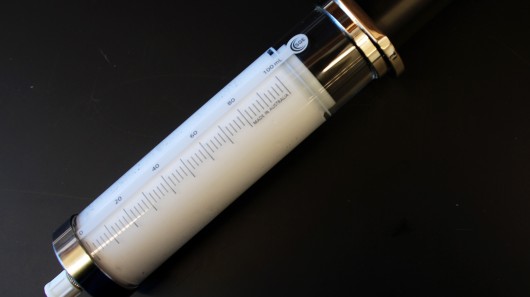Oxygen microcapsules could save lives when patients can't breathe
By Ben Coxworth
10:39 June 29, 2012
Six years ago, Dr. John Khier of Boston Children’s Hospital began investigating the idea of using injectable oxygen on patients whose lungs were incapacitated or whose airways were blocked. He was prompted to do so after a young girl that he was caring for passed away – she succumbed to a brain injury, which resulted when severe pneumonia caused her lungs to stop working properly, which in turn caused her blood oxygen levels to drop too low. Now, Khier is reporting that his team has injected gas-filled microparticles into the bloodstreams of oxygen-deprived lab animals, successfully raising their oxygen levels back to normal levels within seconds.
The microparticles are created using a device called a sonicator, which uses high-frequency sound waves to mix lipids (fatty molecules) and oxygen gas together. This results in the mixture forming into particles about two to four micrometers in diameter, each of which consists of an oxygen core surrounded by a lipid outer shell. Because the particles are so small and flexible, they are able to squeeze through capillaries – by contrast, if straight oxygen gas were injected, bubbles of it could block the blood flow and cause embolisms.
The microparticles are combined with a liquid carrier, so they can then be injected into the bloodstream. That suspension contains three to four times the amount of oxygen as regular red blood cells, so relatively small amounts of it are required, depending on how much of an oxygen level boost is required.
When the microparticle solution was tested on lab animals with blocked tracheas, it was able to keep them alive for up to 15 minutes without their taking a single breath, plus it also reduced low-oxygen-related cardiac arrests and organ injuries.
It is intended that the treatment would be used mainly in emergency response scenarios, to hold non-breathing patients over for 15 to 30 minutes – the carrier liquid would overload the bloodstream if used for longer. Khier and his team envision paramedics, emergency clinicians or intensive care personnel keeping supplies of the microparticle solution close at hand and ready to go, should it be needed.
“This is a short-term oxygen substitute—a way to safely inject oxygen gas to support patients during a critical few minutes,” he said. “Eventually, this could be stored in syringes on every code cart in a hospital, ambulance or transport helicopter to help stabilize patients who are having difficulty breathing.”
Although already-available blood substitutes are capable of carrying oxygen, they still first need to be oxygenated by functioning lungs.
A paper on the research was published this Wednesday in the journal Science Translational Medicine.
Source: Boston Children’s Hospital
Copyright © gizmag 2003 - 2012 To subscribe or visit go to: http://www.gizmag.com

